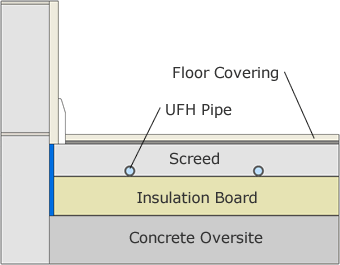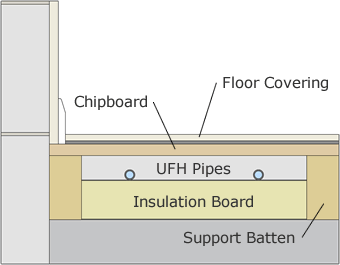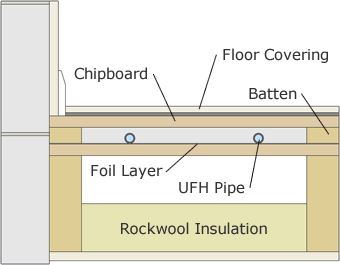Floor Constructions
We provide a variety of floor fixing solutions for our underfloor heaitng systems to suit the various types of floor construction used in projects today.
Solid or beam and block floors

The most common type of floor construction for ground floors, solid concrete or beam and block floors are ideal for underfloor heating as they allow the use of a screed which can act as a thermal mass.
In this setup, the pipes are installed on foil backed rigid-foam insulation(such as Kingspan™ or Celotex™) using self adhesive tracking and clips.
A concrete screed is then laid over the top of the pipes which sets to provide a solid floor ready for your chosen floor covering; screed depths vary depending on the application and type of screed used, the typical screed depth for use with underfloor heating is 50mm.
Suspended timber floors

The most common type of floor construction for upper floors, suspended timber floors are also compatible with underfloor heating.
In this setup, the pipes are installed between the floor joists on foil backed rigid-foam insulation (such as Kingspan™ or Celotex™). The insulation itself is supported by tile battens which are nailed to the inside of the joists.
The pipe is clipped to the insulation board using pipe clips and the ends of the joists are notched to allow the pipe to pass from one channel to the next.
For projects using low temperature heat sources such as heat pumps in conjunction with timber flooring, we recommend a light aggregate mixture is placed over the pipes to act as a mini-screed.
Solid floating floor

Typically used in renovations and for some solid timber floor coverings, this option allows underfloor heating to be installed with a small build-up over the original ground floor height (~75mm) by using battens to form a floating floor.
In this setup, the floating floor battens are spaced at regular intervals across the floor, with rigid-foam insulation boards being placed between the. The underfloor heating pipes are then installed between the battens and secured to the insulation board using pipe clips, much like the suspended timber floor (above).
For projects using low temperature heat sources such as heat pumps in conjunction with timber flooring, we recommend a light aggregate mixture is placed over the pipes to act as a mini-screed.
Suspended timber floating floor

Typically used in timber frame or kit houses where a chipboard floor is installed as part of the construction process, the floating floor option allows underfloor heating to be installed with a minimum build-up over the original floor height (~45mm).
In this setup, a reflective foil is laid over the existing floor and battens installed at regular spacings to form a floating floor. The underfloor heating pipes are then installed between the battens and secured to the chipboard below using nail clips. Thermal and acoustic insulation is provided by rock wool placed between the floor joists and butted up to the end of the joist channels.
For projects using low temperature heat sources such as heat pumps in conjunction with timber flooring, we recommend a light aggregate mixture is placed over the pipes to act as a mini-screed.

